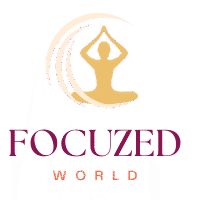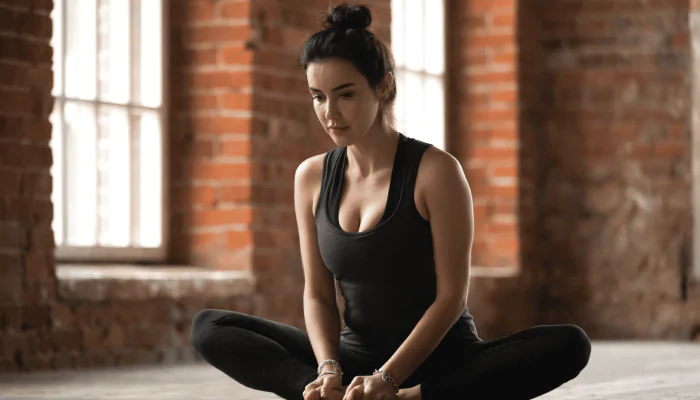What is Bound Angle Pose (Baddha Konasana)?
Bound Angle Pose, also known as Baddha Konasana or the Butterfly Pose, is one of the most accessible seated meditation and yoga positions. In this pose, you sit with the soles of your feet pressed together and your knees falling out to the sides, creating a diamond or butterfly shape with your legs.
The name comes from Sanskrit—Baddha, meaning “bound”, and Kona, meaning “angle.” The pose symbolises openness and grounding, making it a favourite for both meditation and gentle yoga practice.
This position has been practised for centuries, not only for flexibility but also for its calming influence on the nervous system and its ability to encourage stillness in meditation.
How to Perform the Bound Angle Pose
- Begin in a seated position on the floor.
- Bend your knees and bring the soles of your feet together, letting the knees drop out to the sides.
- Hold your feet or ankles with your hands to keep them in place.
- Sit tall with your spine straight, shoulders relaxed, and chin slightly tucked.
- Stay here, breathing gently, while focusing on the stretch through your hips and the calmness of your breath.

If your knees don’t easily touch the floor, don’t worry—place yoga blocks, cushions, or rolled blankets under them for support.
Mental and Physical Benefits
This pose is loved because it offers a combination of physical release and mental relaxation:
- Opens the hips: Stretches the inner thighs and groin, reducing stiffness.
- Supports circulation: Improves blood flow in the pelvic region.
- Encourages grounding: Helps you settle into meditation with ease.
- Relieves tension and stress: Calms the mind after a busy or anxious day.
- Supports digestion: Gentle compression and relaxation of the abdominal region.
- Accessible for beginners: Easier to hold for longer sessions compared to complex poses like Lotus.
Anatomy
When you practice Baddha Konasana, several muscle groups and joints are activated and released:
- Hips and Inner Thighs: Groin and adductor muscles stretch deeply.
- Spine and Core: Core muscles engage lightly to maintain an upright spine.
- Knees: Supported opening of the knees while reducing stress with props.
- Pelvis: Grounded position that stabilises the base for meditation.
This makes the pose both a hip opener and a grounding meditation posture.
How to Know if the Bound Angle Pose is for You
This pose is especially helpful if you’re seeking an accessible alternative to cross-legged sitting. It’s for you if you want to release hip tension, improve flexibility, and create a gentle foundation for meditation.
However, if you experience knee pain, groin strain, or hip injuries, modifications and props are important. You should never force the knees down—let gravity and time open your hips gradually.

Preparatory Poses for Bound Angle Pose
To make the Bound Angle Pose easier and more comfortable, warming up with a few preparatory stretches helps:
- Seated Forward Fold (Paschimottanasana): Stretches the hamstrings and spine.
- Child’s Pose (Balasana): Opens hips gently and encourages relaxation.
- Seated Wide-Legged Forward Fold (Upavistha Konasana): Improves hip mobility.
- Cat-Cow Stretch: Warms up the spine to support upright sitting.
Precautions for Bound Angle Pose
- Avoid forcing the knees: Pressing them down with your hands can strain the joints.
- Support tight hips: Use props if flexibility is limited.
- Care with groin injuries: Enter the pose slowly and avoid overstretching
- Back support if needed: If your lower back rounds, sit on a folded blanket to tilt your pelvis forward.
Tips for Practising Baddha Konasana
- Keep your spine long and tall instead of rounding forward.
- Place a cushion under your hips if sitting flat feels uncomfortable.
- Focus on slow, steady breathing to deepen the relaxation.
- If meditating in this position, close your eyes and allow gravity to work on the hips.
Common Mistakes in Bound Angle Pose
- Slouching or rounding the spine instead of sitting tall.
- Forcing flexibility by pushing knees down aggressively.
- Holding the feet too far away or too close which may strain the hips.
- Skipping props when needed, leading to discomfort and distraction.

Variations of Bound Angle Pose
- Reclined Bound Angle Pose (Supta Baddha Konasana): Lying back with soles of feet together—deep relaxation and chest opening.
- Dynamic Butterfly: Flapping the knees gently up and down to warm up the hips.
- Supported Bound Angle Pose: Using blocks under the knees for comfort in long holds.
Conclusion
Bound Angle Pose (Baddha Konasana) is one of the most accessible and soothing meditation positions, making it perfect for beginners and advanced practitioners alike. It opens the hips, improves circulation, and helps calm the mind—all while being gentle and supportive.
With the right props, mindfulness, and awareness of common mistakes, this pose can become a go-to practice in your meditation journey. Whether you sit upright or recline back in its variations, Baddha Konasana creates a safe and grounding foundation for relaxation, meditation, and inner peace.

